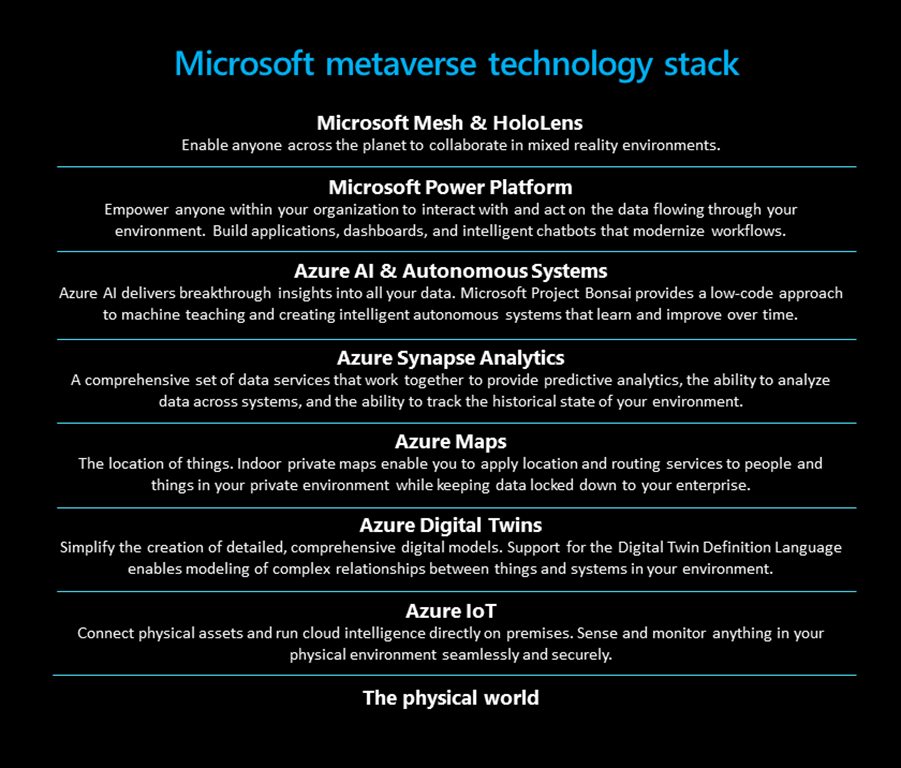26
May

A little over a year ago, Microsoft Build 2020 was Microsoft’s first flagship event to become all-digital early in the COVID-19 pandemic. We wanted to ensure we were there to support developers, who had become more critical than ever to business and societal continuity during the pandemic. During these most challenging times, developers have enabled businesses large and small to continue growing, transforming, and even reimagining the way they fulfill their purpose of supporting their customers and employees.
Microsoft Azure’s mission is to help people and organizations invent with purpose. We are proud to support developers—in many ways, the digital-first responders and pioneers of our generation—and the broader organizations they drive with their innovation. At digital Microsoft Build 2021 this week, we announced a host of new capabilities that help developers create intelligent, connected, and secure cloud-native apps that harness the power of data and AI and run anywhere. Below are the key stories we landed this week at Microsoft Build, with ways to explore for more details.
Increase developer velocity with Microsoft’s end-to-end developer platform
As a company built by developers and for developers, our goal at Microsoft is to provide them with the agility to address the real-world needs of
26
May

Cloud and edge computing are coming together as never before, leading to huge opportunities for developers and organizations around the world. Digital twins, mixed reality, and autonomous systems are at the core of a massive wave of innovation from which our customers already benefit.
From the outside, it’s not always apparent how this technology converges or the benefits that can be harnessed by bringing these capabilities together. This is why at Microsoft Build we talk about the possibilities this convergence creates, how customers are already benefitting, and our journey to making this technology easier to use and within reach of every developer and organization.
The possibilities of connected environments
Imagine taking any complex environment and applying the power of technology to create awe-inspiring experiences and reach new business heights that were previously unimaginable. The possibilities are endless: A retail store where the shopping experience is optimized in real-time and shelves are always stocked. A supply chain that tracks and reduces carbon emissions. A process manufacturing line that adjusts for variations in natural ingredients and automatically detects and compensates for operational bottlenecks. A city plan that simulates various growth proposals to ensure they’re making the best use of energy sources.
26
May

Successful digital transformation requires eliminating unnecessary barriers. To that end, we announced Azure Synapse Analytics in November 2019, where we removed the barriers between data warehousing and big data analytics. And in 2020, we took this a step further and announced Azure Synapse Link for Azure Cosmos DB to break down the barriers that had long existed between operational data and analytical systems.
Over the past two years, customer feedback has made it clear that when data barriers are dissolved the impact of analytics grows exponentially. Today, we’re announcing the next step in bringing data insights to all by eliminating the barrier between business applications and analytical systems with Azure Synapse Link for Microsoft Dataverse.
Introducing Azure Synapse Link for Dataverse
The barrier between business applications data and analytical systems is a critical factor that impedes accelerated time-to-insight. As developers use platforms such as Microsoft Power Apps, Microsoft Power Automate, and Microsoft Dynamics 365 to create and manage business applications, the data that comes from these applications is massive. Today, customers store and manage this data in Dataverse—a common store for all Microsoft business applications. However, when customers want to discover deep insights from the data within Dataverse it
26
May

Customers around the world take advantage of Microsoft Azure to build, deploy, and manage business-critical applications at scale. We continuously innovate to help customers simplify their app deployment and management experience so they can spend more time building great solutions. Today, we are announcing several additional Azure infrastructure capabilities to help achieve this goal.
Simplify your declarative deployment experience in Azure with Bicep
With developers depending heavily on cloud infrastructure to run the apps they create, we continuously strive to simplify the infrastructure setup experience so they can stay focused on the actual innovation and experiences they are crafting within their apps. Azure Resource Manager (ARM) templates are extremely powerful; however, they can be complex. Bicep, an open-source, domain-specific language (DSL), further simplifies developers’ declarative deployment experience in Azure. Bicep makes it much easier to both read and write infrastructure-as-code in Azure.
Bicep allows customers to deploy Azure resources with many of the conveniences of modern programming languages—now indispensable to any app developer’s workflow. It supports first-class tooling with Visual Studio Code integration and has features such as type safety, modularity, and concise, readable syntax. Bicep is a transparent abstraction over ARM templates, which means everything you can do in
26
May

“Tech companies born with an open-source mentality get it. It’s our ability to work together that makes our dreams believable, and ultimately achievable; we must learn to build on the ideas of others”—Satya Nadella, CEO, Microsoft
Microsoft has always been a developer-first organization, and we are striving to make our tools and platforms better to serve developers. In that spirit, Azure is designed to give developers control over their infrastructure and provide the greatest flexibility regardless of operating system, database, language, deployment tool, or methodology, and to extend those options on-premises and to the edge. Today, many of those systems are open source: Linux, Kubernetes, Spark, and Python—just some of the best-known examples. And so Azure has been built to run those technologies, either at the infrastructure as a service (IaaS) or platform as a service (PaaS) levels, through Linux running in virtual machines (VMs), or our Azure Kubernetes Service (AKS) for cloud-native development, often in tandem with one of our managed services for popular open-source databases.
We are committed to open source at Microsoft. We contribute to Linux, Kubernetes, Visual Studio Code, and serving in open-source organizations like the Cloud Native Computing Foundation (CNCF) or Open Source Security Foundation (OpenSSF). At
25
May

The global population of developers is estimated to reach 71.5 million in 2030, an increase of 44.5 million developers from today1. Each new developer brings their ideas and innovations that they’d like to share with the world. It is our mission to empower this next generation of developers with world-class tools and cloud services that allow them to build the applications of the future.
These applications of the future will be intelligent, infused with AI to provide advanced insights. They will incorporate open-source technology and libraries from across the globe. They will be reliable under load and secure by design. And they will be built with tools that allow developers to move from idea to code to cloud, seamlessly.
We see customers on Microsoft Azure building these applications of the future today, by leveraging cloud-native technologies like containers, Kubernetes, microservices, serverless functions, and API-centric designs.
Mercedes Benz is improving the in-vehicle experience for their customers by delivering applications dynamically over the air, instead of requiring an in-person maintenance visit. PwC is helping ensure their clients are compliant with regulations using an AI-powered system that can mine and analyze documents in seconds instead of weeks. Bosch
25
May

Java is one of the most popular programming languages, used by over seven million developers to create everything from enterprise applications to complex robots. Over the past several years we’ve seen an evolution in the Java ecosystem, with the accelerated growth of open-source tools and frameworks like Spring. Microservice architectures are becoming more prevalent, and developers are building more applications on cloud platforms using containers and managed services. The Java ecosystem is complex and running Java applications in the cloud at an enterprise scale can be challenging. Our customers are asking us to help them modernize their Java applications and run them on an enterprise-grade platform—Azure.
We’ve made substantial investments in Java to support a wide range of customer workloads, from the development of Azure Spring Cloud with VMware as a managed destination for Spring Boot applications to the acquisition of jClarity, and the creation of our Microsoft Java Engineering Group. The Microsoft Build of OpenJDK provides a new supported Java runtime option on Azure with the potential for Azure-tuned optimizations—now generally available. We now support the full range of Java EE and Jakarta EE application servers through collaborations with Red Hat, Oracle, and IBM, with newly released offers
25
May

Over the past year, it’s become clear that businesses navigating these unprecedented times require a new level of agility. Core to this agility is achieving a level of software development excellence that was once thought unimaginable. When it comes to empowering all developers with limitless scale, choice, and possibilities, Microsoft Azure has their back.
Our commitment to developers is to make Azure the best cloud for developing intelligent applications that harness the power of data and AI. At Microsoft Build, we are announcing several exciting new capabilities and offers that make it easy and cost-effective for developers to get started with Azure data and AI services.
Innovate with Azure database services
We are announcing several new capabilities that empower developers to innovate with Azure’s database services. Azure SQL Database’s ledger capability, in preview, provides cryptographic verification for sensitive records. Customers like British Petroleum are already benefiting from this exciting feature. Azure Synapse Link for Microsoft Dataverse provides immediate insights from Microsoft Dynamics 365 and Microsoft Power Platform applications, while Microsoft Power BI streaming dataflows remove any bottleneck from signals to insights. There are also several updates to Azure Cosmos DB to help developers build and modernize high-performance applications at any scale,